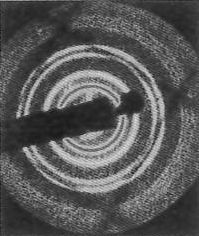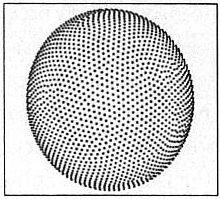


Miscellany
Creating crystals with plasmas
 Time integrated Bragg diffraction pattern of an ion plasma.
Time integrated Bragg diffraction pattern of an ion plasma.
 Simulation of the outer surface of an ion cloud.
Simulation of the outer surface of an ion cloud.
Plasmas, the ionized states of matter, are usually hot and gaseous. However, a sufficiently cold or dense plasma can be liquid or solid. Itano et al., (National Inst. of Standards and Technology, Boulder, Colorado) report the characterization of observing one-component plasma crystals by optical Bragg diffraction. They confine from 105 to 106 beryllium-9 cations at a density of 108 to 109 atoms per cubic centimeter, which is much less dense than normal crystals because there are no anions to screen the Coulomb repulsion. Under appropriate conditions, single crystals with a body-centered cubic (bcc) structure are formed and observed by resonant light scattering, confirming theoretical predictions. In other cases, two bcc crystals form, or a mixture of bcc and face-centered cubic ordering is observed.
W.M. Itano, et al.Science, Vol. 279


